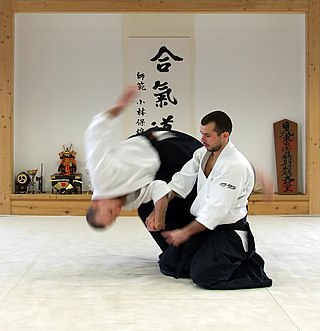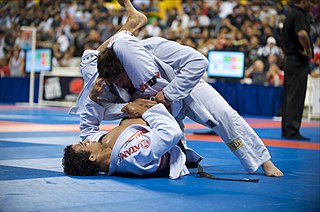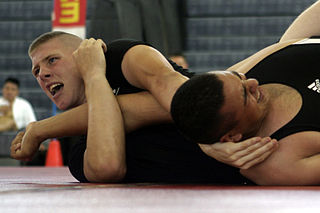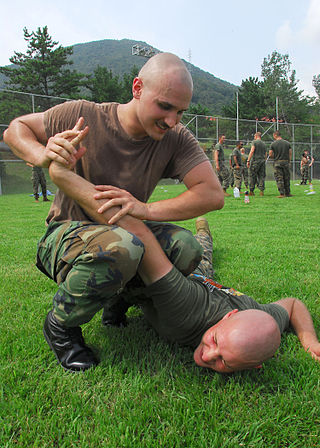This article needs additional citations for verification .(April 2007) |
Jujutsu techniques include joint locks, chokeholds, strikes, grappling, throwing and other self-defense techniques.
This article needs additional citations for verification .(April 2007) |
Jujutsu techniques include joint locks, chokeholds, strikes, grappling, throwing and other self-defense techniques.
Major categories of jujutsu techniques include, but are not limited to: joint locks, chokeholds, strikes, grappling, throwing, and takedowns.
Joint locks can be applied on anything that bends, such as fingers, wrists, elbows, shoulders or knees. Application of locks might include gaining purchase for throwing techniques, encouraging cooperation, submission, or restraining an aggressor. (Such techniques are taught to police forces.) Locks can also be utilised for interrogation/torture or controlling a prisoner prior to securing him using rope. In modern sporting contests, bouts are often concluded upon a submission resulting from a successful joint lock.
Chokeholds including gi-chokes/strangulations (with the lapel), and no-gi. Used primarily to kill or knock unconscious. In combat, a choking technique might permanently dissociate the windpipe from the ligament supporting it, causing death by asphyxiation. Strangulation techniques may also be used for non-lethal subduing of an opponent. Fully blocking the bloodflow to the brain will knock an opponent unconscious in 3 to 7 seconds. [1] To kill by strangulation would take just over a minute before brain death occurs. In modern competition, chokes are normally banned (although they are permitted in judo competition). Strangulation is more popular in competition as they can be applied without fatal consequence, so full leverage can be applied to aid restraining of the competitor. In Jujutsu, there are many counters to choking or strangling attacks. This may have contributed to Jujutsu's popularity in self-defence applications.
Strikes are generally taught, though the specific strike preferences vary by system. In Jujutsu, all known striking techniques are available as tools; nothing is excluded by doctrine. It is the application of those tools that distinguishes different systems of Jujutsu. [ citation needed ]
Jujutsu emphasises the control of an opponent's balance, and therefore most systems of Jujutsu do not advocate any kicks targeted above the Celiac plexus. [ citation needed ]
Atemi is the art of striking pressure points or physiological targets for kuzushi (breaking balance) or to incapacitate an opponent. Atemi is the art of striking the human body in order to cause specific physiological effect for various applications. The term "atemi" is sometimes applied to any technique whose primary purpose is to distract an opponent, setting the opponent up for another technique.
Grappling techniques are also common. Simple grappling was incorporated into early Jujutsu systems for use in combat. More elaborate grappling techniques and strategies were likely developed for use in sporting contests in the ancient world.[ citation needed ] Such techniques have been re-introduced into the Japanese martial arts in post-reformation systems such as Judo and related Brazilian jiu-jitsu systems. In post-reformation Japan, Japanese martial arts were altered under the auspices of Kanō Jigorō and his contemporaries. The emphasis on Samurai combat skills was degraded in preference to systems that could be practiced by anyone of any age for healthy physical education, sport and self-defense. Because of this new emphasis, grappling skills have been adapted to safe sporting environments, where gouging, biting, and other unsporting techniques are banned. Only a few schools maintain the old samurai grappling techniques and training practices. The majority of schools utilise Judo training or a more combative form of grappling.
Takedown is a term for a technique that involves off-balancing an opponent and bringing him or her to the ground, typically with the combatant performing the takedown landing on top. Takedowns are usually distinguished from throws by the forward motion and target of advancement (typically the legs), although in some systems of terminology, throwing techniques are a type of takedown.
There are differences in application of the same technique between styles of Jujutsu that range from the minor to the major.
When performing a forward shoulder roll, some styles roll on the back of the lead-hand (i.e., palm up), and some roll palm-down. While performing a backward shoulder roll, land on your far side hip, palm down.
Some styles perform wrist locks (or, "peels") with the bottom 3 fingers and don't use the index finger, and some use the top 3 fingers keep the pinky off. The intent of both approaches is the same: do not block the opponent's wrist during a peel.
Some styles advocate using "live hand" (hand open) for an armbar takedown, whereas some advocate making a fist. Adherents of each approach claim "more power", though the closed-fist approach arguably offers the additional benefit of reducing the possibility of a finger getting accidentally snagged.
On a hip throw off the right hip (for example), the most common way this throw is taught is to grab the uke's right arm with the left hand. Some styles, however, teach "wrapping" the uke's right arm with the left instead of the grab. Biomechanically, the most effective method is to grab the right upper arm using a monkey style grip.[ citation needed ] Using this method, one grips the opponent's left arm using the 4 fingers and the thumb against the palm, (instead of gripping with the thumb against the 4 fingers). The reason for using this grip rather than a normal human gripping action is that the thumb gripping against the 4 fingers is weaker in strength than the grip applied by the 4 fingers and thumb against the palm (as monkeys do when gripping the branch of a tree to swing). Grabbing the upper arm rather than the wrist allows the body greater pulling torque.
Likewise, on hip throws, some systems grab around the waist (or in ignorance, the belt), and some systems prefer to wrap tori’s right arm under the uke's left. One should never grip the opponent’s belt; modern attire may not include a belt. In fact, grabbing the belt is not necessary. Simply grabbing around the waist (so long as the grip is all the way around the waist) works better anyway. One should note that it feels easier to grab your opponent’s waist with your right arm than it does wrapping your right arm around their left arm. Biomechanically, grabbing the opponent higher up the back (such as at the shoulder) can allow the opponent to bend at the waist making the hip throw more difficult. The sequence of actions required for the hip throw is: block, parry or deflect the opponent's punch if necessary, effect kuzushi, bend the knees and turn whilst pulling the opponent over your hip.
The biggest conceptual difference is when grappling is taught, whether a style views grappling as a sport, or grappling as a necessity of balanced self-defense training (or both). Both applications have merit, and the training will have a considerable amount of overlap, but will also have important differences. The latter approach will need to understand the fundamentals of the grappling positional hierarchy like the former, but the priority will be to get off the ground (and get away) as fast as possible. It is also a very good technique to use when near an opponent.

Aikido is a modern Japanese martial art that is split into many different styles, including Iwama Ryu, Iwama Shin Shin Aiki Shuren Kai, Shodokan Aikido, Yoshinkan, Renshinkai, Aikikai and Ki Aikido. Aikido is now practiced in around 140 countries. It was originally developed by Morihei Ueshiba, as a synthesis of his martial studies, philosophy and religious beliefs. Ueshiba's goal was to create an art that practitioners could use to defend themselves while also protecting their attackers from injury. Aikido is often translated as "the way of unifying (with) life energy" or as "the way of harmonious spirit". According to the founder's philosophy, the primary goal in the practice of aikido is to overcome oneself instead of cultivating violence or aggressiveness. Morihei Ueshiba used the phrase masakatsu agatsu katsuhayabi" to refer to this principle.

Judo is an unarmed modern Japanese martial art, Olympic sport, and the most prominent form of jacket wrestling competed internationally. Judo was created in 1882 by Kanō Jigorō as an eclectic martial art, distinguishing itself from its predecessors due to an emphasis on "randori" instead of "kata" alongside its removal of striking and weapon training elements. Judo rose to prominence for its dominance over established jujutsu schools in tournaments hosted by the Tokyo Metropolitan Police Department, resulting in its adoption as the department's primary martial art. A judo practitioner is called a "judoka", and the judo uniform is called "judogi".

Pankration was an unarmed combat sport introduced into the Greek Olympic Games in 648 BC. The athletes used boxing and wrestling techniques but also others, such as kicking, holds, joint-locks, and chokes on the ground, making it similar to modern mixed martial arts. The term comes from the Greek παγκράτιον [paŋkrátion], meaning 'all of power', from πᾶν (pan) 'all' and κράτος (kratos) 'strength, might, power'.

Brazilian jiu-jitsu is a self-defence martial art and combat sport based on grappling, ground fighting, and submission holds. BJJ approaches self-defense by emphasizing taking an opponent to the ground, gaining a dominant position, and using a number of techniques to force them into submission via joint locks or chokeholds.
Professional wrestling holds include a number of set moves and pins used by performers to immobilize their opponents or lead to a submission. This article covers the various pins, stretches and transition holds used in the ring. Some wrestlers use these holds as their finishing maneuvers, often nicknaming them to reflect their character or persona. Moves are listed under general categories whenever possible.

A strike is a directed physical attack with either a part of the human body or with an inanimate object intended to cause blunt trauma or penetrating trauma upon an opponent.

Submission wrestling, also known as submission grappling, submission fighting or simply grappling, is a competitive martial art and combat sport that focuses on ground fighting and submission techniques. It is a hybrid discipline that incorporates elements of various grappling arts, mostly Brazilian jiu-jitsu but also Judo, Sambo, and wrestling. Submission wrestling is practiced both as a competitive sport and as a training method for self-defence and mixed martial arts (MMA).

A chokehold, choke, stranglehold or, in Judo, shime-waza is a general term for a grappling hold that critically reduces or prevents either air (choking) or blood (strangling) from passing through the neck of an opponent. The restriction may be of one or both and depends on the hold used and the reaction of the victim. While the time it takes for the choke to render an opponent unconscious varies depending on the type of choke, the average across all has been recorded as 9 seconds.

Yoseikan budō (養正館武道) may be classified as a sōgō budō form, but is used here to indicate a martial art into which various martial ways have been integrated. It is probably most widely known for its descent from a pre-war style of aikido; however, it has important connections to judo, karate, western boxing, savate, and a traditional forms of Japanese combat known as gyokushin-ryū jujutsu and Tenshin Shōden Katori Shintō-ryū.

The rear naked choke (RNC) is a chokehold in martial arts applied from an opponent's back. The word "naked" in this context suggests that, unlike other strangulation techniques found in jujutsu/judo, this hold does not require the use of a keikogi ("gi") or training uniform.

The guillotine choke, also known as Mae Hadaka Jime in judo, is a chokehold in martial arts applied from in front of the opponent, often on the ground but can also be done while standing. The choke involves using the arms to encircle the opponent's neck that bears a resemblance to the blade of a guillotine.
An armlock in grappling is a single or double joint lock that hyperextends, hyperflexes or hyperrotates the elbow joint or shoulder joint. An armlock that hyper-extends the elbow is known as an armbar, and it includes the traditional armbar, the shoulder triangle armbar, and the shotgun armbar. An armlock that hyper-rotates the arm is known as an armcoil, and includes the americana, kimura, and omaplata. Depending on the joint flexibility of a person, armcoils can either hyper-rotate only the shoulder joint, only the elbow joint, or both the elbow joint and shoulder joint.

Clinch fighting is the part of stand-up fighting where the combatants are grappling in a clinch, typically using clinch holds. Clinching the opponent can be used to eliminate the opponent's effective usage of some kicks, punches, and melee weapons. The clinch can also be used as a medium to switch from stand-up fighting to ground fighting by using takedowns, throws or sweeps.

A grappling hold, commonly referred to simply as a hold that in Japanese is referred to as katame-waza, is any specific grappling, wrestling, judo, or other martial art grip that is applied to an opponent. Grappling holds are used principally to control the opponent and to advance in points or positioning. The holds may be categorized by their function, such as clinching, pinning, or submission, while others can be classified by their anatomical effect: chokehold, headlock, joint-lock, or compression lock. Multiple categories may be appropriate for some of these holds.

A wristlock is a joint lock primarily affecting the wrist-joint and, in some cases, the radioulnar joints through rotation of the hand. A wristlock is typically applied by grabbing the opponent's hand, and bending and/or twisting it. Wristlocks are very common in martial arts such as aikido, hapkido and jujutsu where they are featured as self-defense techniques. They are also used as submission holds in martial arts such as Brazilian jiu-jitsu and catch wrestling. While being an illegal technique in modern sambo and judo competitions, it is still practiced in judo forms of self-defense kata kōdōkan goshinjutsu. Wristlocks are also widely used as pain compliance holds, often in police, military, and residential treatment centers.

Yoseikan Aikido is the aikido taught at the Yoseikan Dojo in Shizuoka, Japan, under the direction of Minoru Mochizuki.

Jujutsu, also known as jiu-jitsu and ju-jitsu, is a family of Japanese martial arts and a system of close combat that can be used in a defensive or offensive manner to kill or subdue one or more weaponless or armed and armored opponents. Jiu-jitsu dates back to the 1530s and was coined by Hisamori Tenenouchi when he officially established the first jiu-jitsu school in Japan. This form of martial arts uses few or no weapons at all and includes strikes, throws, holds, and paralyzing attacks against the enemy. Jujutsu developed from the warrior class around the 17th century in Japan. It was designed to supplement the swordsmanship of a warrior during combat. A subset of techniques from certain styles of jujutsu were used to develop many modern martial arts and combat sports, such as judo, aikido, sambo, ARB, Brazilian jiu-jitsu, and mixed martial arts. The official date of foundation of Jiu Jitsu is 1530.
Aikido techniques are frequently referred to as waza 技. Aikido training is based primarily on two partners practicing pre-arranged forms (kata) rather than freestyle practice. The basic pattern is for the receiver of the technique (uke) to initiate an attack against the person who applies the technique—the 取り tori, or shite 仕手, also referred to as (投げ nage, who neutralises this attack with an aikido technique.
Atemi Ju-Jitsu, in Japanese: Atemi (当て身) Jujutsu (柔術), also called Pariset Ju-Jitsu, was established in France in the 1940s by the late Judo and Ju-Jitsu legend Bernard Pariset to revive and preserve old martial techniques inherited from Feudal Japan.